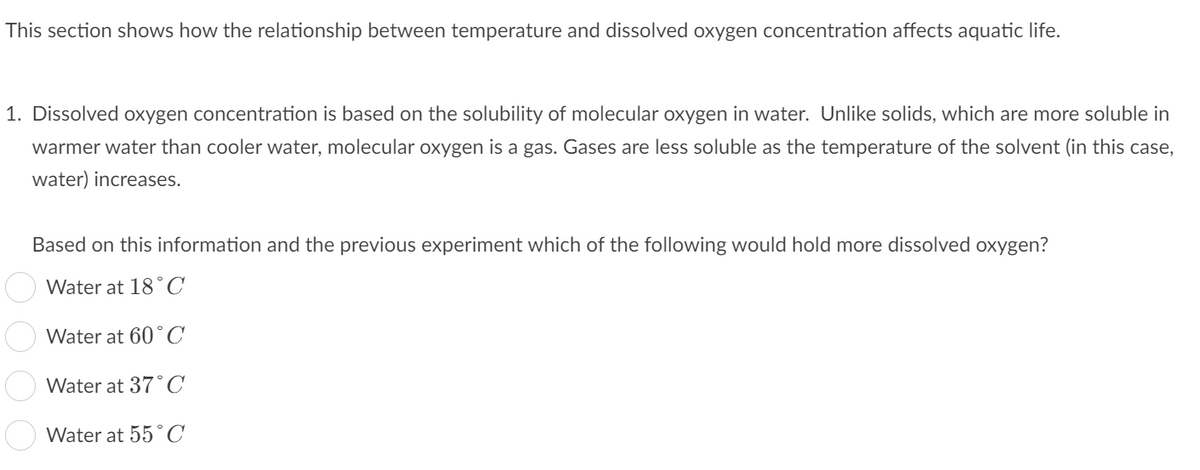This section shows how the relationship between temperature and dissolved oxygen concentration affects aquatic life. 1. Dissolved oxygen concentration is based on the solubility of molecular oxygen in water. Unlike solids, which are more soluble in warmer water than cooler water, molecular oxygen is a gas. Gases are less soluble as the temperature of the solvent (in this case, water) increases. Based on this information and the previous experiment which of the following would hold more dissolved oxygen? Water at 18°C Water at 60°C Water at 37°C Water at 55°C
This section shows how the relationship between temperature and dissolved oxygen concentration affects aquatic life. 1. Dissolved oxygen concentration is based on the solubility of molecular oxygen in water. Unlike solids, which are more soluble in warmer water than cooler water, molecular oxygen is a gas. Gases are less soluble as the temperature of the solvent (in this case, water) increases. Based on this information and the previous experiment which of the following would hold more dissolved oxygen? Water at 18°C Water at 60°C Water at 37°C Water at 55°C
Chemistry: The Molecular Science
5th Edition
ISBN:9781285199047
Author:John W. Moore, Conrad L. Stanitski
Publisher:John W. Moore, Conrad L. Stanitski
Chapter13: The Chemistry Of Solutes And Solutions
Section: Chapter Questions
Problem 127QRT
Related questions
Question

Transcribed Image Text:This section shows how the relationship between temperature and dissolved oxygen concentration affects aquatic life.
1. Dissolved oxygen concentration is based on the solubility of molecular oxygen in water. Unlike solids, which are more soluble in
warmer water than cooler water, molecular oxygen is a gas. Gases are less soluble as the temperature of the solvent (in this case,
water) increases.
Based on this information and the previous experiment which of the following would hold more dissolved oxygen?
Water at 18°C
Water at 60°C
Water at 37°C
Water at 55 °C
Expert Solution
This question has been solved!
Explore an expertly crafted, step-by-step solution for a thorough understanding of key concepts.
This is a popular solution!
Trending now
This is a popular solution!
Step by step
Solved in 2 steps with 1 images

Knowledge Booster
Learn more about
Need a deep-dive on the concept behind this application? Look no further. Learn more about this topic, chemistry and related others by exploring similar questions and additional content below.Recommended textbooks for you

Chemistry: The Molecular Science
Chemistry
ISBN:
9781285199047
Author:
John W. Moore, Conrad L. Stanitski
Publisher:
Cengage Learning

Chemistry: An Atoms First Approach
Chemistry
ISBN:
9781305079243
Author:
Steven S. Zumdahl, Susan A. Zumdahl
Publisher:
Cengage Learning


Chemistry: The Molecular Science
Chemistry
ISBN:
9781285199047
Author:
John W. Moore, Conrad L. Stanitski
Publisher:
Cengage Learning

Chemistry: An Atoms First Approach
Chemistry
ISBN:
9781305079243
Author:
Steven S. Zumdahl, Susan A. Zumdahl
Publisher:
Cengage Learning


Chemistry
Chemistry
ISBN:
9781305957404
Author:
Steven S. Zumdahl, Susan A. Zumdahl, Donald J. DeCoste
Publisher:
Cengage Learning


Chemistry: Principles and Reactions
Chemistry
ISBN:
9781305079373
Author:
William L. Masterton, Cecile N. Hurley
Publisher:
Cengage Learning